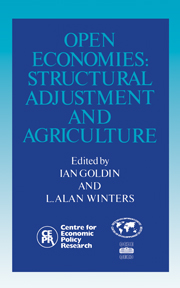Book contents
- Frontmatter
- Contents
- List of figures
- List of tables
- Preface
- Acknowledgements
- List of conference participants
- 1 Introduction: from macro to maize
- Part One Open economy analysis
- 2 Sequencing and welfare: labour markets and agriculture
- Discussion
- 3 Agricultural adjustment and the Mexico-USA free trade agreement
- Discussion
- 4 Do the benefits of fixed exchange rates outweigh their costs? The CFA Zone in Africa
- Discussion
- 5 Adjustment and the rural sector: a counterfactual analysis of Morocco
- Discussion
- Part Two The small country assumption and trade reform
- Part Three Risk and adjustment
- Part Four Government's role
- Index
Discussion
from Part One - Open economy analysis
Published online by Cambridge University Press: 04 August 2010
- Frontmatter
- Contents
- List of figures
- List of tables
- Preface
- Acknowledgements
- List of conference participants
- 1 Introduction: from macro to maize
- Part One Open economy analysis
- 2 Sequencing and welfare: labour markets and agriculture
- Discussion
- 3 Agricultural adjustment and the Mexico-USA free trade agreement
- Discussion
- 4 Do the benefits of fixed exchange rates outweigh their costs? The CFA Zone in Africa
- Discussion
- 5 Adjustment and the rural sector: a counterfactual analysis of Morocco
- Discussion
- Part Two The small country assumption and trade reform
- Part Three Risk and adjustment
- Part Four Government's role
- Index
Summary
Chapter 3 is an ambitious, and a quite successful, attempt to analyse the economic consequences of the free trade agreement (FTA) between the USA and Mexico for maize, and fruits and other vegetables. In order to do this, the authors decompose the population of Mexico into six categories (subsistence workers, landless workers, owners of rain-fed land, owners of irrigated land, urban workers and urban capitalists) and display in great detail the welfare implications of the trade agreement on each of these segments of the population.
Let us start with the analysis of maize. Maize is a commodity that is subsidised both at the level of the consumer and at the level of the producer. Removing all trade barriers and domestic subsidies consequently hurts both demand and supply, which is a rare combination. In order to get an upper bound to the impact of such a drastic move towards freeing all subsidies, one can readily turn to Table 3.5, column 3, in which the impact on all categories is reported, at a stage when the decision to migrate is not yet taken. One sees that the benefit for the government will amount to about 0.8 per cent of GDP which, for a single commodity, is indeed quite outstanding. In order to analyse the potential Pareto improvements of this measure, Levy and van Wijnbergen then proceed in two stages. They analyse the resources that are freed when the government compensates, in utility terms, all segments of the population: (1) when not taking account of the decision to migrate, (2) when taking account of the decision to migrate.
- Type
- Chapter
- Information
- Open EconomiesStructural Adjustment and Agriculture, pp. 63 - 65Publisher: Cambridge University PressPrint publication year: 1992



